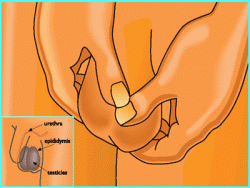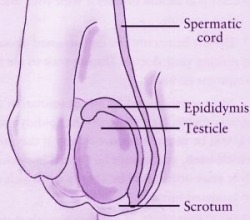What is a Testicular Self Exam
A testicular self exam (TSE) is a procedure which men use to examine their testicles in order to identify lumps which can be a early sign of testicular cancer.
Purpose of a Testicular Self Exam
To familiarize yourself with the normal size, shape, and consistency of your testicles, making it easier to identify changes and abnormalities in the future.
How to Perform a Testicular Self Exam

1. The best time to examine your testicles is during or after a hot bath or shower. This helps the skin of the scrotum (skin that covers the testicles) to become relaxed, which makes it easier to examine the testicles.
2. It is also helpful to stand in front of a mirror while examining the penis, scrotum, and testicles. You want to check for swelling.
3. Hold the penis out in front and out of the way and examine each testicle separately, one at a time.
4. Hold the testicle between your thumbs and fingers with both hands and roll the testicle gently between your fingers with slight pressure. It is best if the index and middle fingers are placed under each testicle, with the thumbs on top.
5. You should also be able to feel the epididymis (carries the sperm), which feels soft, rope-like, slightly tender to pressure, and is located at the top of the back part of each testicle. This may feel like a lump which is a normal finding.
6. Remember that it is also normal to have one testicle slightly larger than the other, which is a common finding for most men.
7. You want to look and feel for any hard lumps, bumps, nodules (smooth rounded masses), or any change in the size, shape, color, or consistency of the testes. You also want to note if you experience any pain during your examination of the testes.
8. Become familiar with the normal size, shape, and weight of each testicle and epididymis. This will help you recognize a change from one self-examination to another.
What to look for
If you notice any swelling, lumps, or changes in the size or color of a testicle, or if you have any pain in your groin, please see your doctor. Lumps, swelling, or changes in consistency may not be testicular cancer, but should be checked by your healthcare provider as soon as possible. Testicular cancer is highly treatable, especially with early detection!
Video Demonstration
Please visit this website to view an educational video demonstration on how to perform a testicular self examination.

